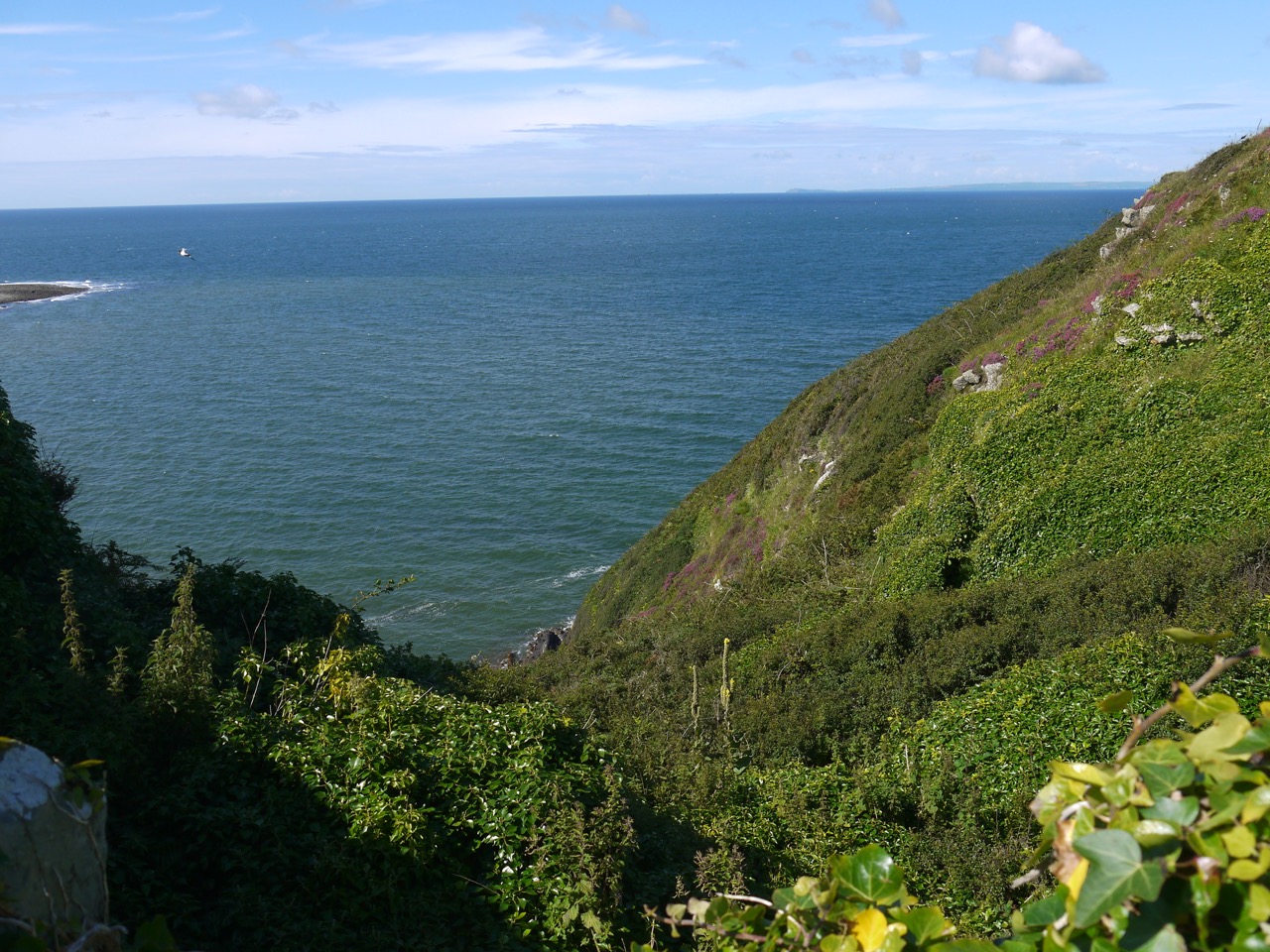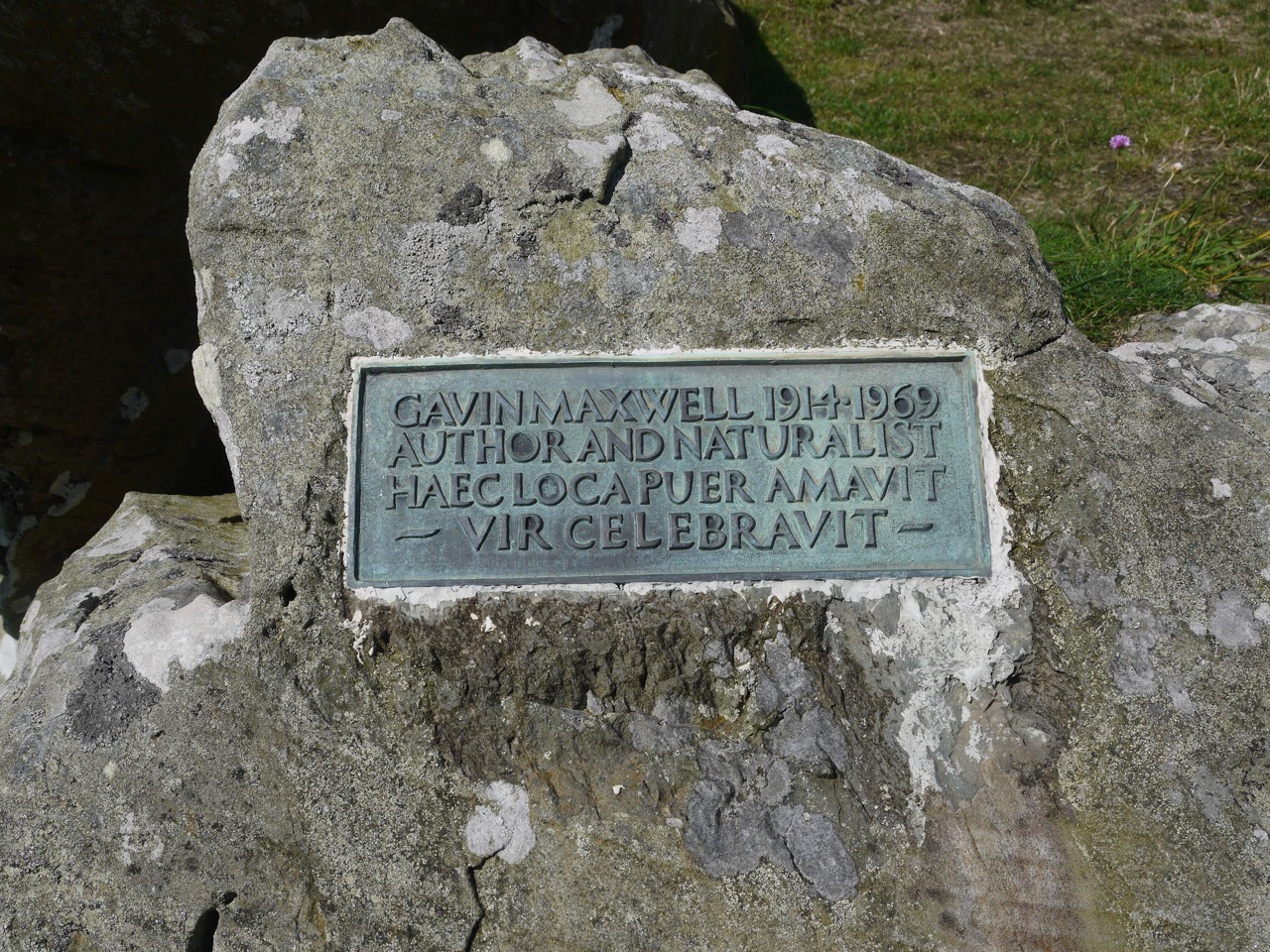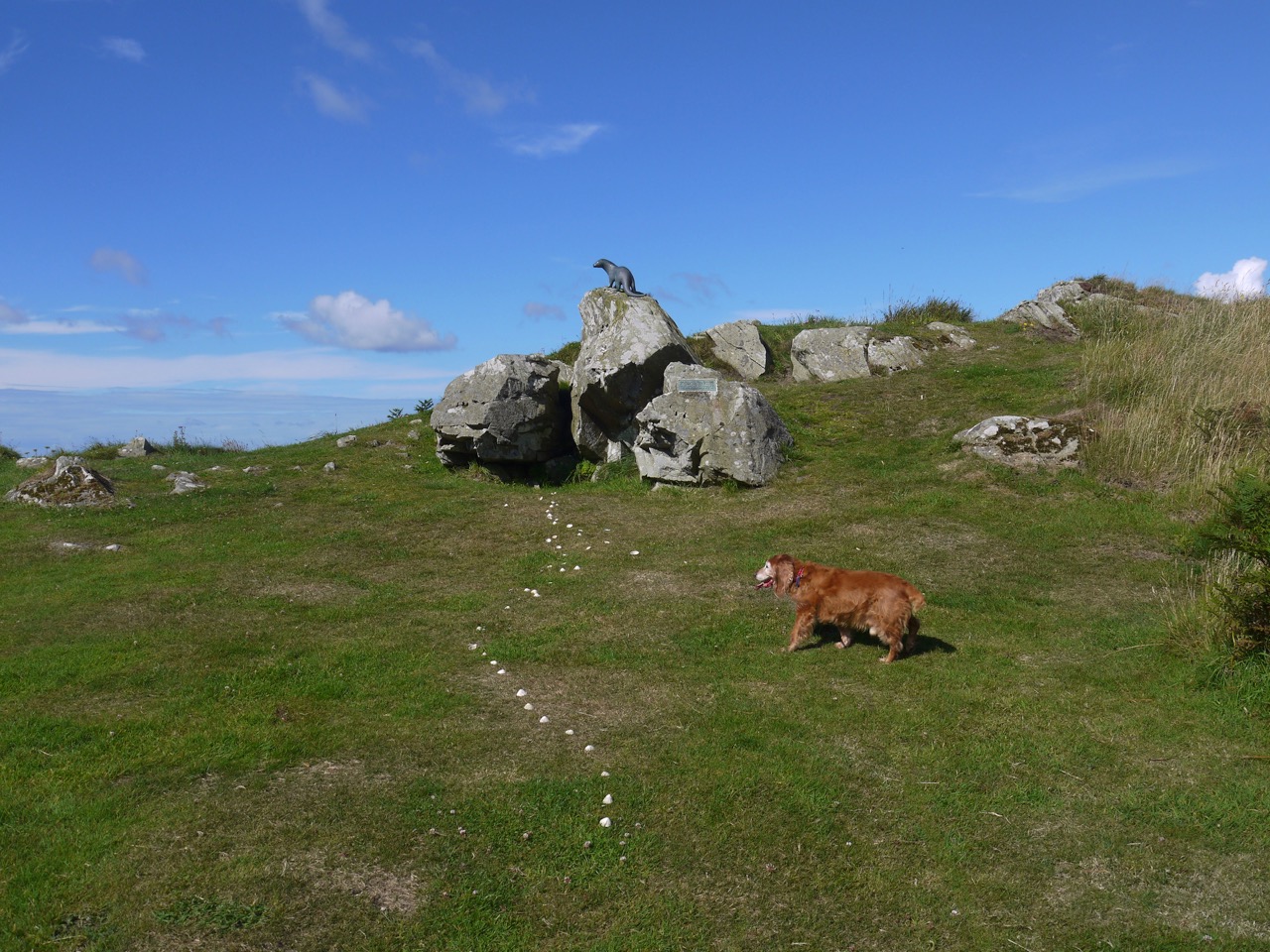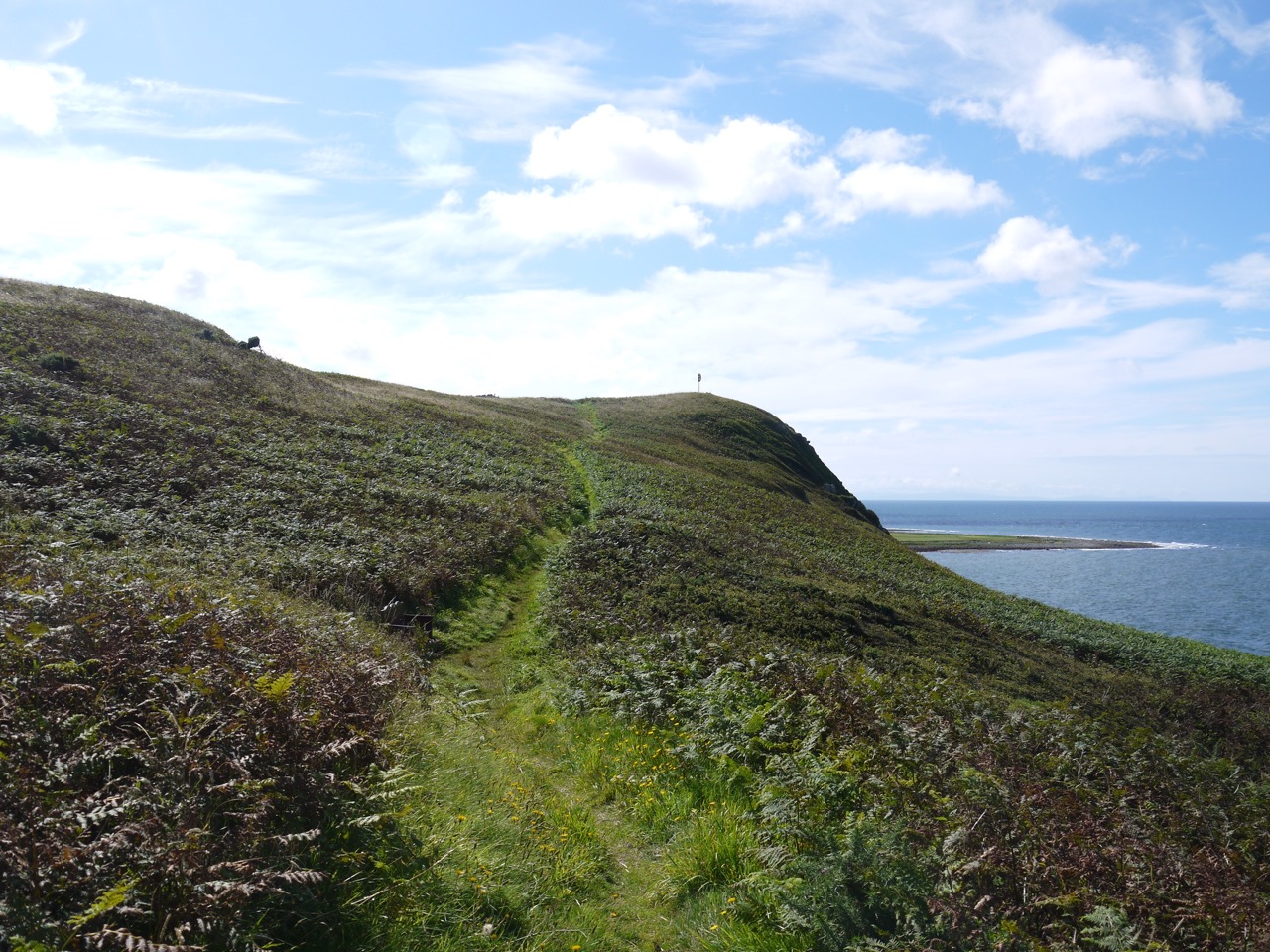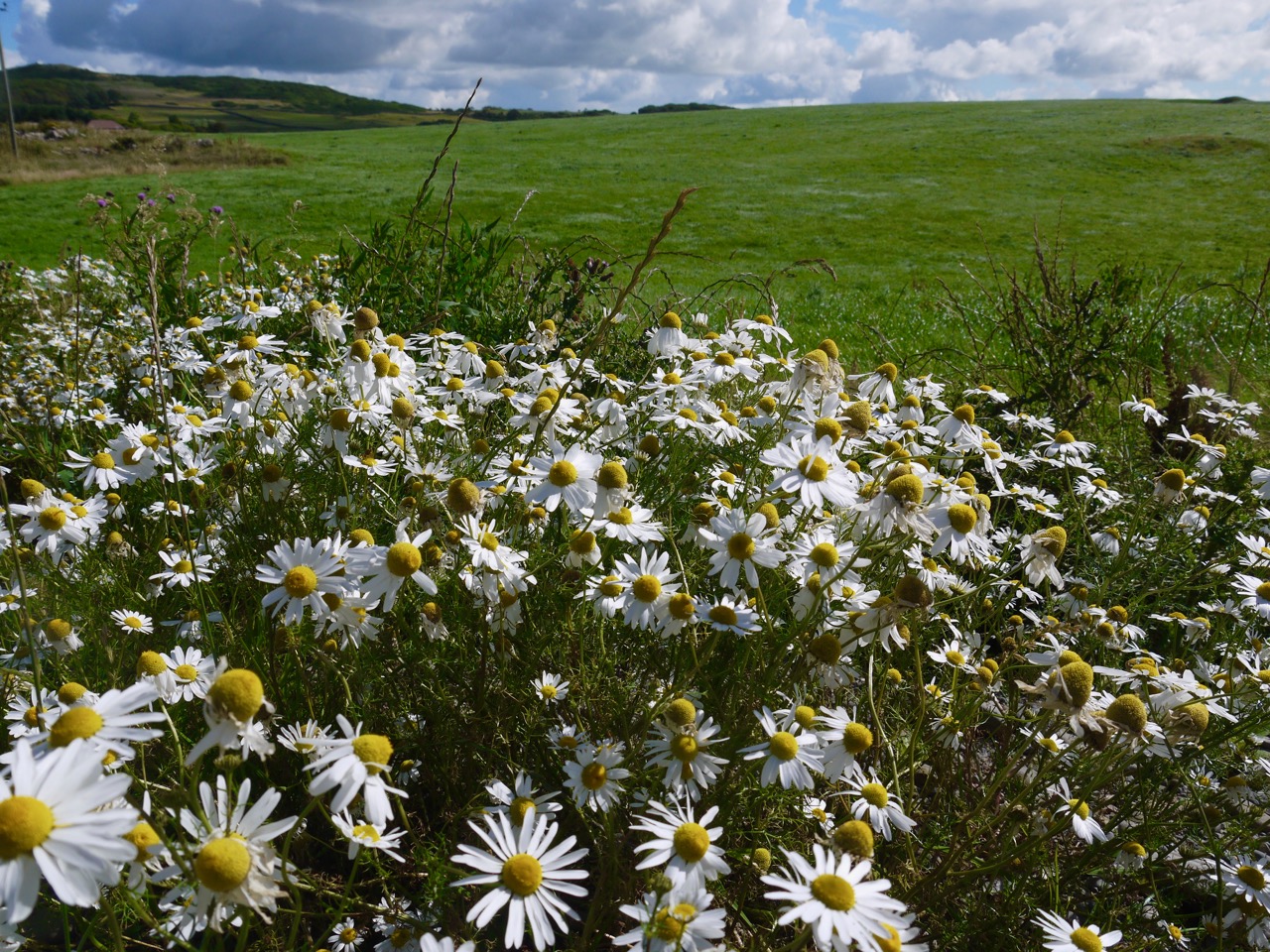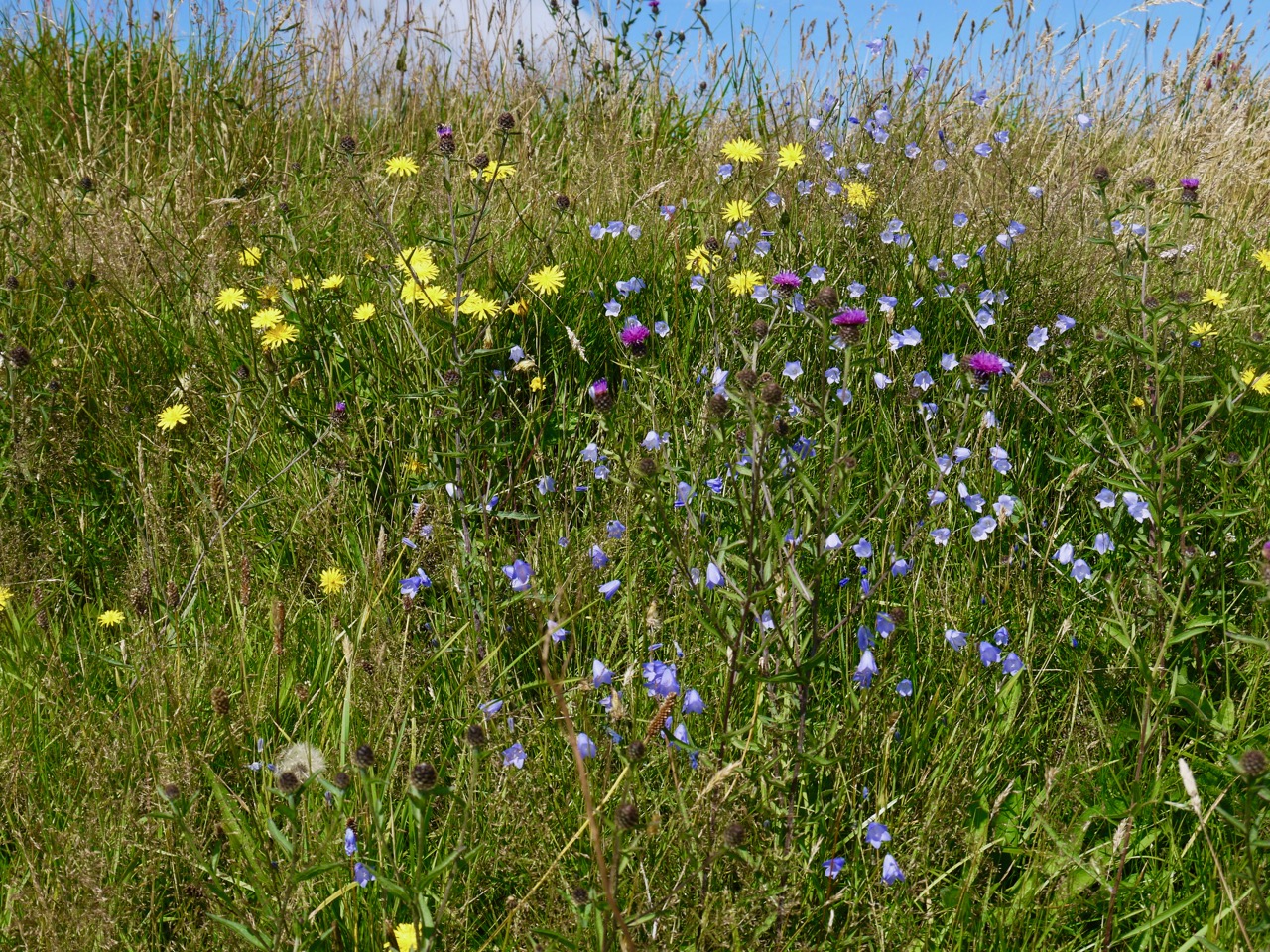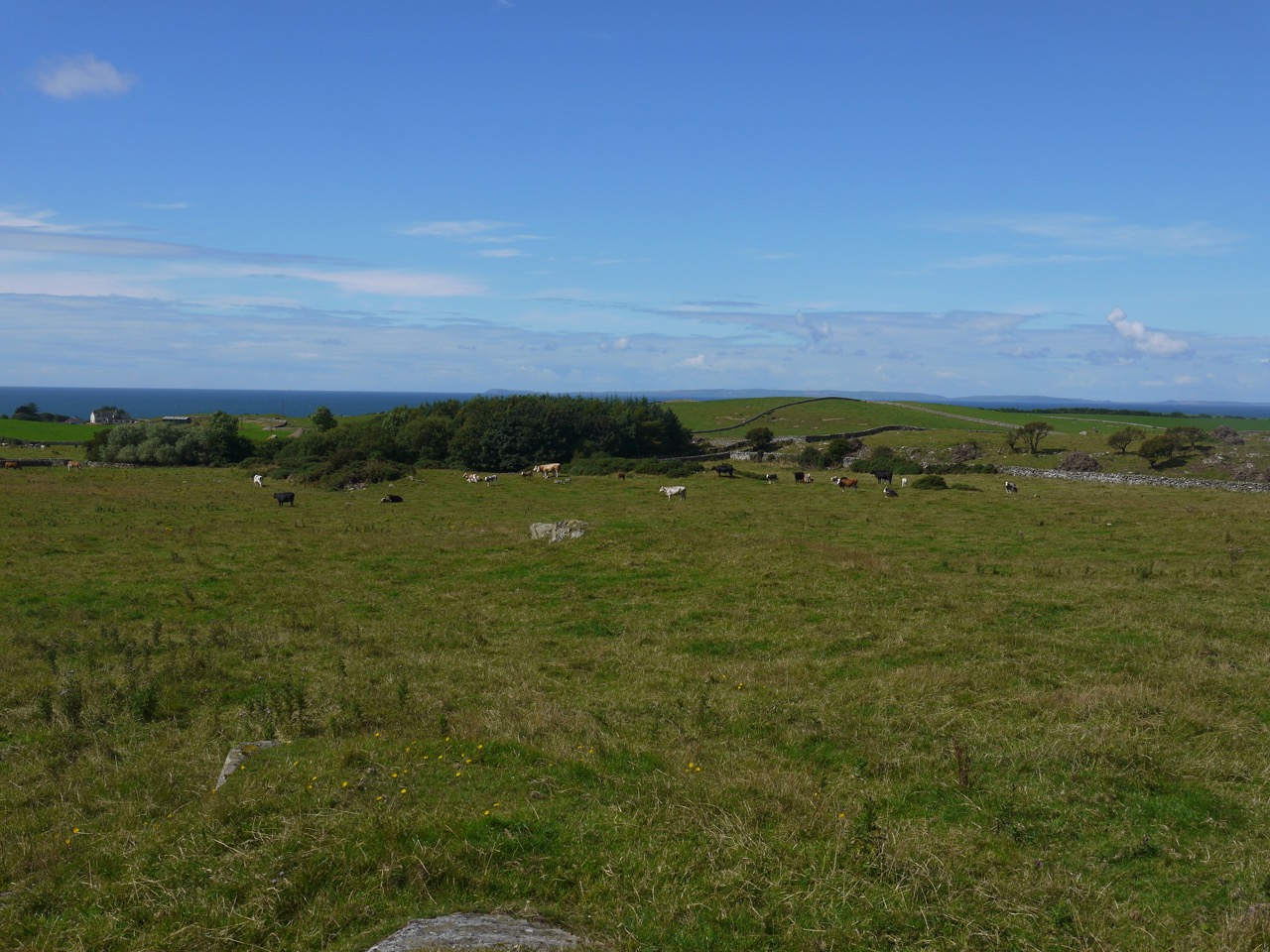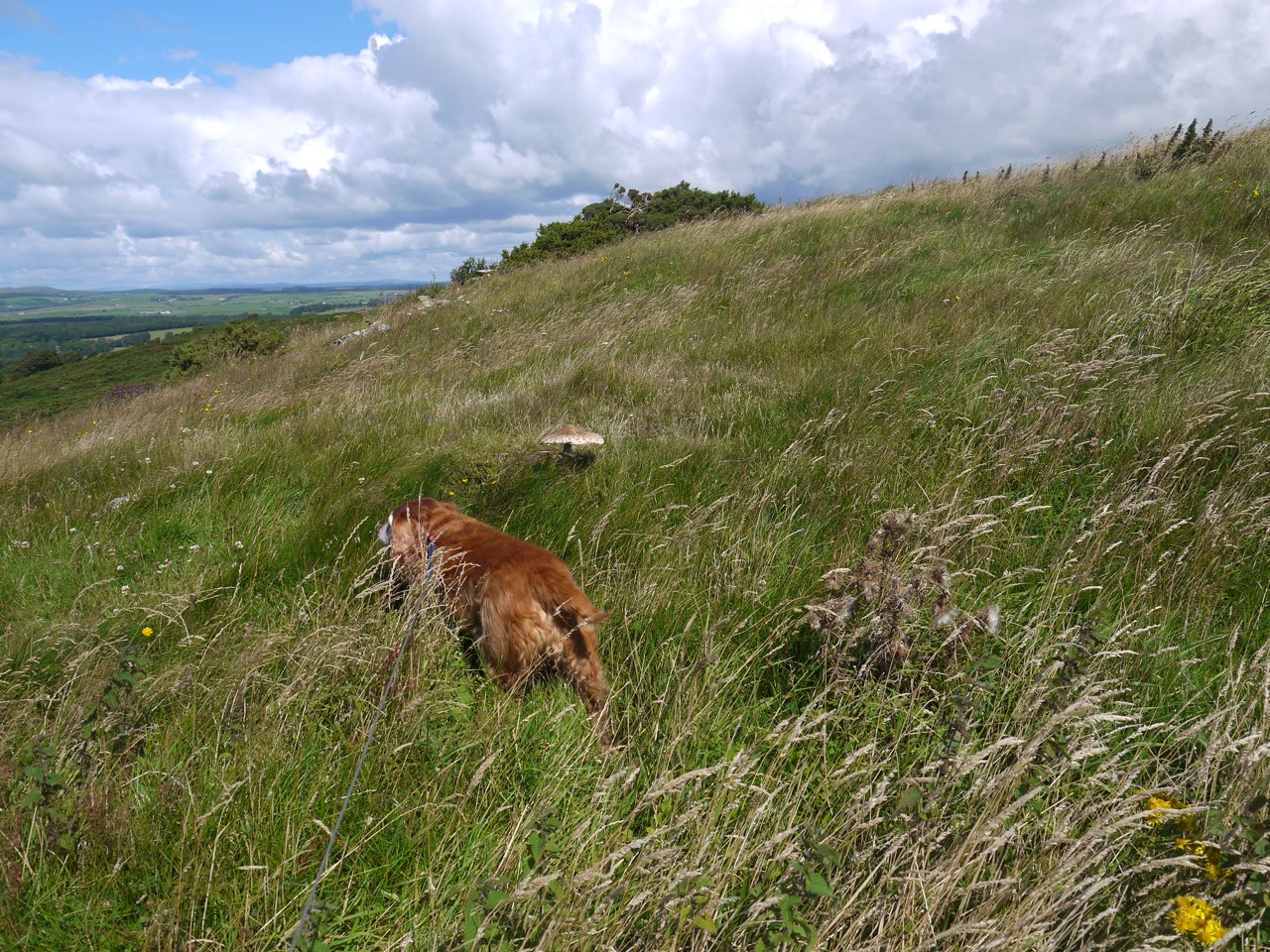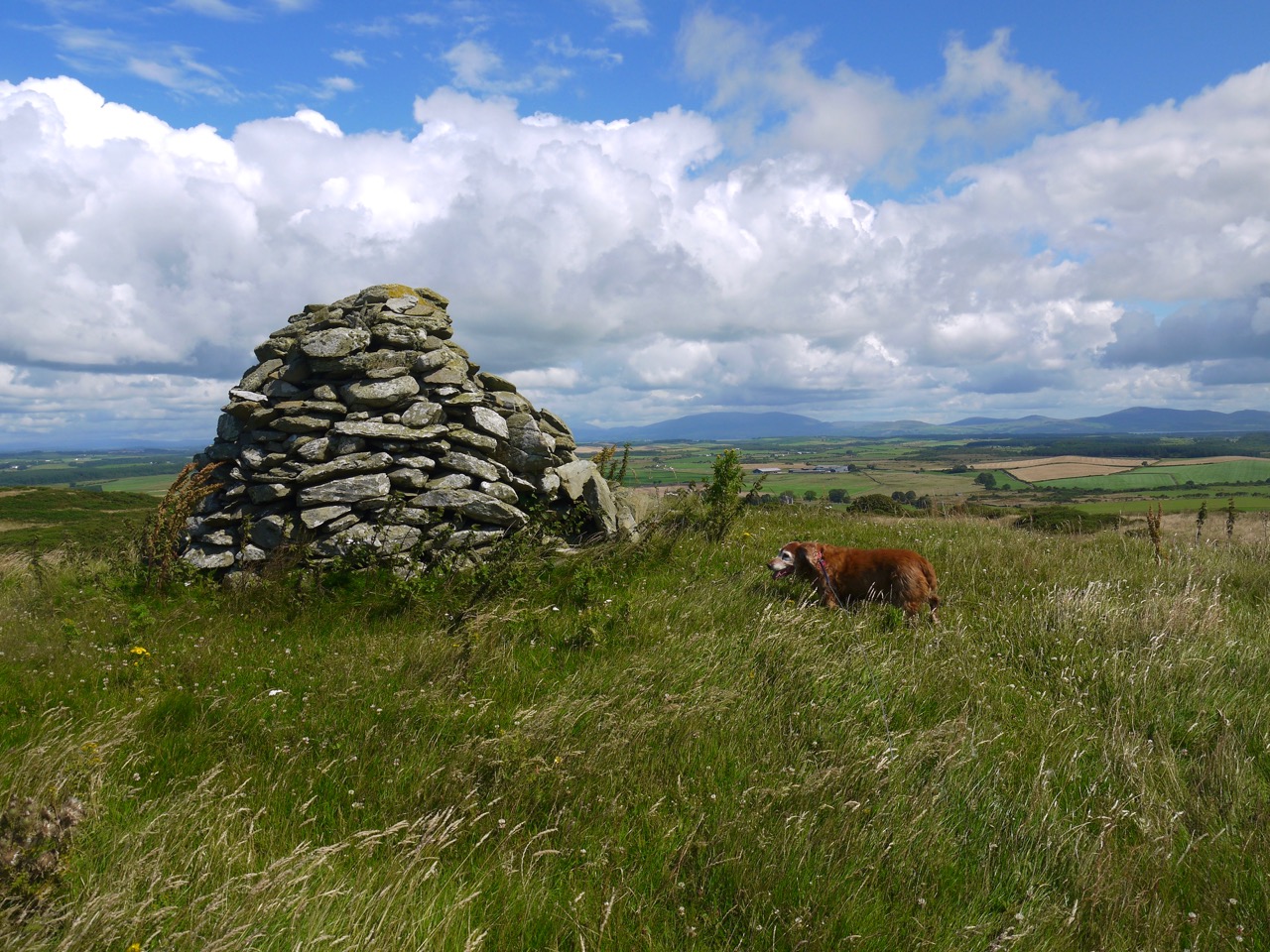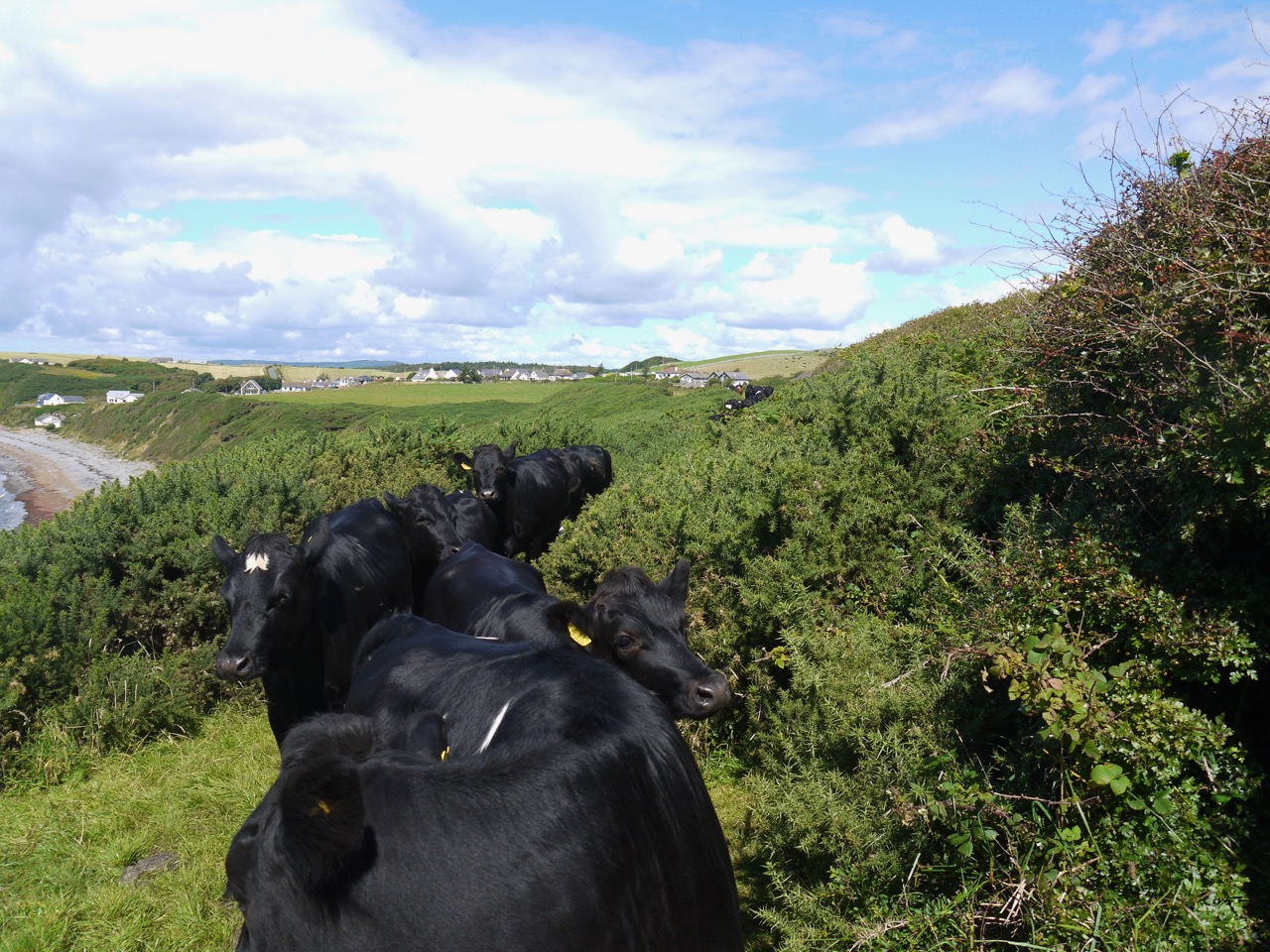3.6 miles 1h 50m (strolling pace!) 122m ascent
Fell of Barhullion
The planned Cumbria Way (Sethera) walk was delayed by a respiratory virus, so I had a free day for walking and an old dog hankering for an outing. So it was that Sweep and I set out to conquer the Fell of Barhullion.
The drive there was straightforward, or so it seemed on the map, but somewhere after Bladnoch I must have drifted into navigational autopilot and found myself driving into Garlieston (“home of the Mulberry Harbour”), a place I was not expecting to pass through. The extra time taken with the detour was perhaps fortuitous though since it allowed the rain the pass and by the time we arrived at St Medan, the sun was shining.
We parked in a car park by St Medan Golf Course which I though would give us easy access to both the beach and the hill. The car park was empty when we arrived and full when we returned. And as I said, the sun was shining. In fact there wasn’t any evidence that it had rained there at all.
Sweep isn’t up to long walks but doesn’t know to take it easy, so I set the pace, going along at a leisurely stroll. Well that’s my excuse.
We headed up towards the Maxwell monument, with the remains of Kirkmaiden church below us. The monument is a bronze life-sized otter atop some rocks. A plaque explains it is dedicated to Gavin Maxwell and its latin inscription held my attention while I dredged up my high school Latin for translation.
When I stepped back to get some photos I noticed a sign which has it in English. “This place he loved as a boy. And made famous as a man.” Which is pretty much the gist of my translation, though there is some poetic licence in the sign’s version.
The bronze otter was commissioned by the Galloway Wildlife Trust and sculpted by Penny Wheatley to commemorate Gavin Maxwell, the author of Ring of Bright Water, who grew up in nearby Elrig.
When I first saw the otter I thought there was a line of mushrooms leading up to it, but on closer inspection they were seashells. There was excellent visibility, with the Isle of Man and Mull of Galloway clearly seen. I could even make out the lighthouse on the latter. Closer by, I could also see the cairn on the Fell of Barhullion.
After the otter we made our way along a path along the top of some cliffs and I felt obliged to strike out through the bracken to investigate a structure at the top of the cliffs. It looked like a round basketball goal seen from behind but turned out to be a large red circle. It doesn’t look to be something that is being maintained. Another thing to add to my “what the hell is that” list. Something to do with the lighthouse perhaps?
The clifftop path took us through a gate that did not have a latch but opened away from us and closed itself. It would prove very useful a little later in the day.
The path disgorged us into a field and presented a choice. There was a wall dividing the field and the worn ground suggested that most of those passing crossed the wall at an opening just beside us. The problem was that that part of the field was filled with cows and they were mostly blocking the way through the break in the wall. I decided to stay away and hope we could get out from our side of the wall. As it turned out, our side of the wall was the one giving access to the exit gate but there was also a break in the wall so either way would work.
There was one beast in our part of the field, a calf. I’m no expert but something tells me this was born last year rather than this. It seemed quite invested in us and lollopped over to us like a big puppy and tried to play with Sweep. I was a bit worried it would inadvertently squash him so we made our way past and it seemed to lose interest.
A steel gate took us though some trees to the A747 and we crossed to walk along a farm track to Stellock. A sign told us we were on the footpath to the Fell of Barhullion. There were plenty of flowers in the hedgerows including the first knapweeds I’ve seen this year. A field to our left had a standing stone.We had to negotiate a couple of cattle grids but these had gates beside them.
We passed a large stand of Mayweed and then walked on through flower filled meadows.
It wouldn’t be a normal walk for me if there wasn’t a route deviation and for me this happened at Stennock Farm. On the map the route turns right after the farm, and this we did, going through a gate then turning right. This took us along a track between stone walls. It looked to have been much used by cattle in that the ground was churned and consisted of semisolid slurry with stones sticking up, but often too far apart to act as stepping stones. Sweep was pretty much wading and I was doing my best to avoid overtopping my boots. The one positive thing I took from this was that this was obviously a throughway for the cattle and should lead us to the fields. It didn’t.
It was a dead end. I could have climbed a wall but that was not an option for Sweep and I didn’t fancy manhandling a dog that had been dipped in cow shit. So we did a 360 and retraced our steps through the mud.
At the farm I saw my error. We followed the track that I had thought was turning into the farmhouse but actually went around the farm. This took us to the field that would allow us up to the hill. There were some puddles here. Well to be honest, the path ran under a large shallow section of water. But this proved useful in cleaning us up a little.
As is often the case, the gate into the field swung across a large muddy puddle, so having been through clean water a couple of minutes earlier, we had to walk through “muddy” water again.
This field had cows and calves, but they were quite spread out and we gave them a wide berth by walking around the far side of the field. Though it may not be obvious from the photograph, this field had raised rocky areas (dry), grassy sections (dry), and boggy sections (churned and wet). Our wide berth route seemed to favour the latter terrain, but we avoided the animals.
A final gate took us into a wild meadow and the final small climb to the top. We met a hare while walking here. It must have been hoping that we would walk past, and indeed Sweep must have past it by, but my foot was too close. I felt it run across my left foot before I heard it, and it was away into the tall grass without Sweep noticing. We met it again or another hare on the way down and Sweep did give make a token effort with that one, but it ran though a nearby hole in a wall.
The Fell of Barhullion takes its name from bar-chuileann, hilltop of hollies, and I learnt a new word when I read that the Fell part of the name is pleonastic, meaning an unnecessary addition (as in free gift). Well it may well have once had holly when it was named but none remains. There was also once a hill-fort here, and the lines of its walls are still evident on aerial photos, but I would have been pushed to see them on the ground. The summit has a large cairn, which is said to be modern, which stands well above the trig pillar.
We stopped for a rest at the summit and spent some time enjoying the views. I ate cherries and Sweep had gravy bones.
And rested we set off back the way we had come, Sweep leading the way. The cattle near Shellock had re-grouped though and were now spread across the field. Avoiding the field didn’t seem an option so we found a way to weave around the cows, avoiding the calves and keeping close to clumps of undergrowth or rocks that we could put between us and them.
We had a more difficult time in the field at Clarksburn (where we had met the inquisitive calf earlier). There were now cows in both parts of the field, but nothing too worrying. Some were on the other side of the wall, where we didn’t need to go, and the others were at the right side of the field whereas we need to walk along the left edge, with a wall separating us from the other cows.
As soon as we started across the field the cows stirred. It was like something from a horror film where the zombies or robots notice our heroes and start to shamble towards them. The cows watched us then they all started to walk towards us, a large cow leading the way. I didn’t want to encourage them so I didn’t run since I’m sure they could outrun us. It quickly became obvious that the cows would reach us before we could get across the field.
When the first cow reached us she stopped and sniffed Sweep then gave him a nudge with her nose. Only a small nudge, the kind she might give a calf, but quite a nudge for a dog. She moved to nudge again and I pulled him out of the way. I could feel a cow was right behind me by its breath on my neck and I was worried that if the cows hurried any more we might be trampled so we walked on “calmly” but without dawdling. The cows followed us onto the clifftop path which at least put them in single file, and I decided against making a run for it through the bracken since they could easily follow. At last the self closing gate came into view and we put it between us and the cows.
My standard operating procedure for being frightened by cows would have been to let the dog loose and clamber on to the nearby wall, but I wasn’t sure the old dog would actually run away.
Anyway we both caught our breath and spent a little longer than we otherwise might at the otter monument.
I had intended going down to the beach and visiting the remains of Kirkmaiden Church, but the dog had had a longer walk than he had had for some time, so I’ve put that off for another day.
I’ll leave you with a description of St Medana, who is the maiden of the church’s name.
St. Medana, who is described as an Irish maiden who took upon
herself a vow of perpetual chastity, and being solicited by a
certain miles nobilis, who would not take ” no ” for an answer,
sailed for Scotland with two handmaidens. Landing in the
Rhinns of Galloway (paries Galvidie superiores que ryndis
dicuntur), she led a life of poverty. But the knight followed
her, and drove her to take refuge with her two companions
on an insulated rock in the sea. This rock, in answer to
her prayers, became a boat, in which she was carried a
distance of 30 miles, ad terrain gue fames didtur (Kirkmaiden
in Glasserton), where the relics of the holy virgin (Medana)
now repose. Again the knight followed her to her retreat,
and arrived at the house where she and her two maids were
sleeping. A cock crew and awoke her, when she took refuge
in a high tree. ” What do you see in me,” said she, ” to
excite your passion” ” Your face and eyes,” he replied :
whereupon she tore out her eyes and flung them at his feet
He, moved to penitence, departed ; she descended from the
tree, and, being in want of water to wash her bleeding face,
a fountain miraculously sprang from the root of the tree.
The rest of her life she spent in sanctity and poverty under
St. Ninian.
[osmap gpx=”http://www.screel.co.uk/walks/wp-content/uploads/2017/08/RK_gpx-_2017-08-05_1038.gpx”]


